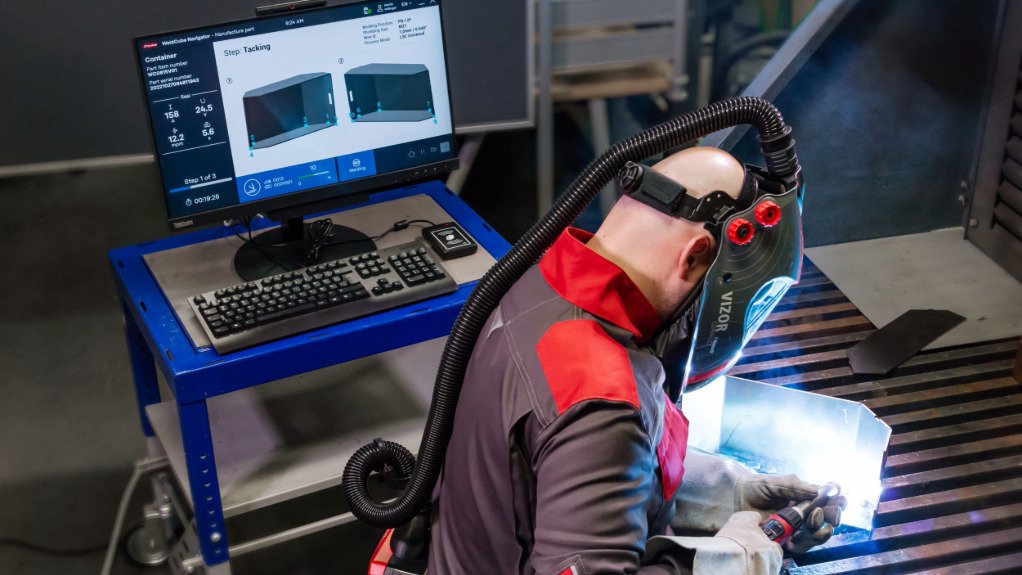Introducing a level of digital control traditionally only seen in fully automated systems, welding technology provider Fronius’ WeldCube Navigator is being implemented by fastener specialist Bolt and Engineering Distributors Group (B.E.D.).
The adoption of the WeldCube Navigator system forms part of B.E.D.’s efforts to assist customers in improving weld quality, reducing production errors and addressing operational inefficiencies.
The system was recently tested at an automotive manufacturing facility producing around 700 units a day. The company approached B.E.D. to help resolve persistent issues on its manual welding line.
“The repetitive nature of these tasks was leading to operator fatigue, quality inconsistencies and frequent errors – particularly as South Africa’s welding skills gap remains a concern,” states Fronius welding specialist Edric van der Walt.
Following a joint technical collaboration with Fronius in Austria, B.E.D. conducted a WeldCube trial for the client, providing operators with clear, step-by-step welding instructions.
The system uses visual prompts to guide users through the welding process – including positioning, clamping and applying welds – with automatically selected, preconfigured parameters for every step. This lowers the margin for error while standardising quality across shifts and operators.
“Most weld defects stem from incorrect machine settings. This solution removes that risk by ensuring [that] even operators with limited experience can deliver consistent, high-quality welds,” states B.E.D. welding specialist Marcel Pretorius.
Welders are limited to a defined number of welds per cycle, and unless those are completed correctly, it will not permit the part to move forward on its own with progression to the next production stage, which is only permitted if all the required quality criteria are met.
This early-stage quality control feature is crucial for maintaining quality output in high-volume environments; prior to the system’s implementation, welding defects were often discovered only further down the line. Even small process errors can be detected and corrected immediately, helping to reduce scrap and costly rework.
Smarter Welding
In many industrial applications, full robotic welds are not viable, owing to financial or technical constraints and labour challenges, particularly when dealing with complex geometrics or varying product configurations.
The WeldCube Navigator system enables manufacturers to retain manual welding while solving the traditional variability problem through human-operated, machine-guided processes.
The system can also assist in the training of operators and bolstering skills development. It helps novice operators perform welds without needing detailed technical knowledge of the machine setup.
This “significantly shortens the learning curve for new welders. They can concentrate solely on applying the welds correctly, improving both their efficiency and their skill set in a controlled, low-risk environment,” Pretorius stresses.
WeldCube Navigator also includes detailed logging, with every operator logging in using a personal near-field communication tag, with all weld data recorded under their credentials.
Consequently, manufacturers can trace issues back to individual users, identify recurring problems and implement targeted training. Additional features include barcode scanning, which enables traceability at component level.
“If a problem emerges with a finished product, teams can pinpoint exactly who welded it, when, and under what conditions. This ensures full accountability and traceability across the production chain,” Pretorius explains.
The system can be used for numerous parts and processes, as manufacturers can upload their welding sequences and instructions. The interface can be set up to prompt operators for part-specific tasks, with step-by-step guidance and instructional photos.
The WeldCube Navigator also supports compliance and quality audits. While it does not enforce specific in-house or industry-specific thresholds, if a weld exceeds the set parameters, the system logs the incident and alerts the operator.
“This enables manufacturers to create a complete quality record, supporting audits, certifications and customer transparency,” states Van der Walt.
Meanwhile, B.E.D. provides technical support through its nationwide network, which enables the company to respond quickly to customer needs, whether for installation, training or troubleshooting.
Van der Walt cites an instance in which a field engineer from Fronius reached a customer within minutes of being contacted to resolve a production-related issue.
This support extends to forecasting customer needs and managing local stock levels to reduce downtime during equipment failures or spare part requirements.
“Support is not limited to installation; it is about partnership. We ensure help is never far away and that’s vital in welding, where after-sales service accounts for up to 80% of long-term value,” Pretorius emphasises.
The WeldCube Navigator can also be fully integrated into a plant’s programmable logic control system, providing an additional level of control for highly automated production lines - a feature not commonly available in all welding systems.
B.E.D. regularly hosts customers at the Fronius Technology Centre in Kayalami, where they can experience new technologies first-hand and better understand how these can solve their specific welding challenges.
While the technology may appear advanced, the system is intentionally simple to use. It was designed for environments where repetitive welds, high production volume, limited welding skills, or high rework/scrap rates are common, making it a practical choice for real-world South African manufacturing environments.
Van der Walt concludes that by combining digital control, real-time feedback, traceability and localised support, the WeldCube Navigator offers a practical solution for South African manufacturers aiming to enhance welding quality and workforce efficiency. ![]()






